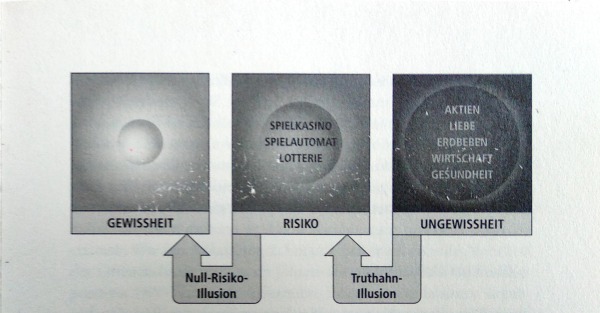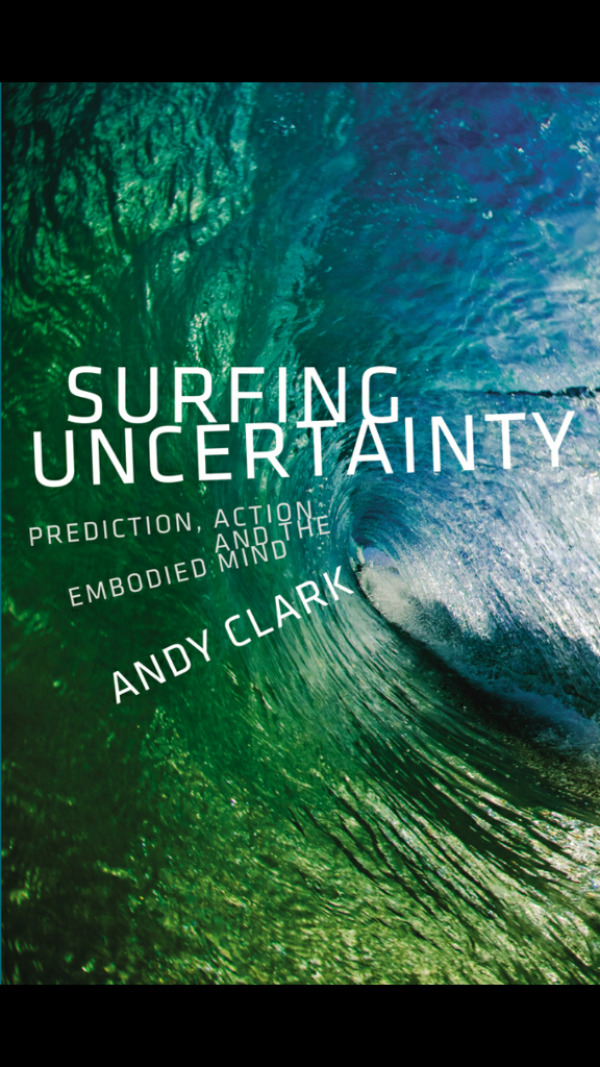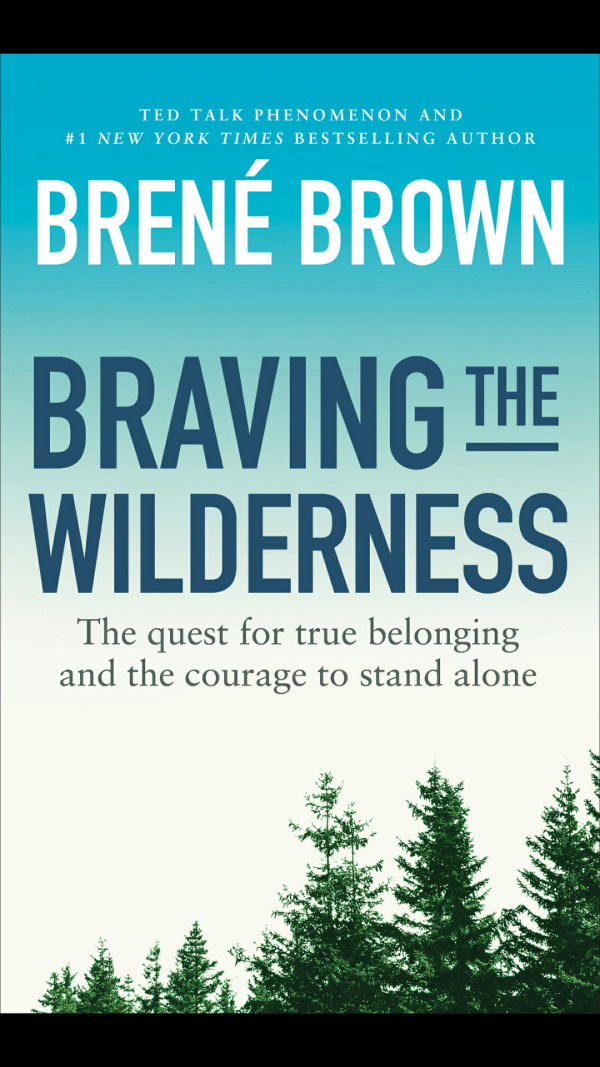Book review - Risksavvy, Surfing uncertainty, Braving the wilderness
feed books psychology economy organization decision risk management robotics AI intelligence computational ethology Review of three books all in one
After reading Gigerenzer’s Risksavvy I started out doing a meta-review of five books I’ve had on decision making and risk management. Yukkes, topic proved too sticky and I got stuck. To break the stuckness, and new books were coming in waiting to be reviewed, I decided to go for a five-sentences-for-each-book approach. Here we go, on average more than five sentences but within reasonable bounds. Hope you enjoy, all three recommended.

Book review: Risiko by Gerd Gigerenzer

A recommendation by rakso2
Risiko, aka Risksavvy as the original English title, by Gerd Gigerenzer is a book about decision making.
The decisions we make every day a number of times are usually connected with uncertainty, and thus risk.
Take the later train and not waste time or take the earlier train and leave some maneuvering space to still take a cab, if the train is delayed or cancelled, Berlin example.
Essentially we are making decisions in face of three types of outcome scenarios: certainty, risk (which is known uncertainty), and unknown uncertainty. The most important bit is to determine, which of the three scenarios we are in, in order to then select the appropriate decision strategy. If we don’t watch our back, we might be taken by an illusion, and treat a risky situation as if we would be dealing with certainty, through the zero-risk illusion, or treat a totally uncertain situation as if we knew the uncertainties, by the turkey illusion. This is illustrated in the picture below, taken from the German edition of the book. The risk- and uncertainty scenarios each have a couple of domain examples where they apply. The bottom line is that just about any domain with true relevance like love, economy, or health are in fact subject to total uncertainty. Alas, on average these domains are treated as if they were about known uncertainties, which leads to gross calamity.

Risksavvy makes a clear voice for the use of heuristics, in face of the last of these three scenarios, in favor over optimization and the purely rational stance as taken by Kahneman.
I met Gerd Gigerenzer earlier this year and we discussed decisions, flatcat, and his new book.
The definition of a startup by Eric Ries is “an institution to develop a product under circumstances of extreme uncertainty.”
The book is very well written, sits on a sound body of quantitative results and reasoning, and is loaded with incredible stories from pension plans, health care, and more. I read the German edition but trust in the translation.
In additional Gigerenzer launches the clear idea of putting the relevant subjects (statistics, psychology) into primary school curricula, which I fully support as a sustainable policy. Quote from Alison Schrager
Gigerenzer believes we should teach risk and probability literacy the same way we teach reading or basic math.
Annotated set of the top five quotes.
Since I read German edition on paper, it is not verbatim quotes but my own compressed notes, then translated to English.
Some actual heuristics
- Always ask what is the reference class, percent of what? p16
- Always ask, what is the absolute increase in risk? p18
- In case of a conflict between reason and strong emotion, do not use arguments but use a strong emotion with an opposite sign. p25
- Checklists in aviation vs. in hospitals. If in the hospital and you are able to, always ask “do you use checklists?”. The difference here, is that on the airplane, the crew is also stakeholder in the safety, where in the operating room, the crew is not. p76
- Ask a doctor not for recommendation but what he/she would do. p81
- Ask waiter not for recommendation but what he/she would eat. p90
- Satisficing, one-reason decision making, good for dating, hiring, and similar. p191
Some philsophy
- Three rules: everyone can learn to deal with uncertainty, experts are part of the problem rather than the solution, less is more p27
- Intuition and rules of thumb: assuming intelligence is necessarily conscious is a huge mistake. p46
- Many experts and the public: more is better (information, computation, optimization). But, less is most often more. p58
- Heuristics: accuracy-effort trade-off p58
- A system that does not make mistakes is not intelligent. Intelligence means going beyond existing perceptions and taking risks. p64
- Representative survey in the EU, is the following statement true? “Ordinary tomatoes do not contain genes, whereas genetically modified tomatoes do”. 36% false, 41% true, 23% don’t know. p102
- Financial experts predict worse than dice (EUR - USD rate, stock prices). 10 years of always 50/50 probability to predict correctly, there remain about 10 “experts” from an initial 10000 who always predicted correctly. p120
- Fear of personal responsibility leads to second-rate decisions. p121
These are not heuristics but jocular illustrations of some of the problems.
- Paul Volcker: The invention of the ATM is the only useful innovation ever made by banks. p140
- Nation of lawyers, created by lawyers for lawyers. p238
- Make predictions all the time, but don’t keep records. p122
- Banks: 3-6-3 business model, savings get 3% interest, loans yield 6% interest, be at the golf course at 3 o’clock p289
Translated with https://www.DeepL.com/Translator (free version)
Book review: Surfing uncertainty by Andy Clark

A recommendation by Guido Schillaci a Roboticist and AI reseacher
Andy Clark is a prolific advocate of the radically predictive view of brain function, the predictive brain hypothesis.
The work revolves around expounding the implications of the predictive view of the organization of neuronal activity, as exemplified by the publications of Friston and colleagues.
While alternatively called the free energy principle of brain organization or the active inference principle, or yet something else, this view is the first to make a categorical difference by flipping the whole idea of behavior from the stimulus-response principle over to the prediction-error principle.
That means that animals are not driven by the stimuli coming in from the environment whereupon they are free to choose a response. Rather, they are actively seeking out stimuli through their actions and shaping their experience just a tad ahead of the passive flow of things.
Do you realize what this means?!!
It completely breaks the traditional view of stimulus-response, sense-think-act, and so forth by a categorical shift. In computational terms, this make a statement about what is the entry point of the sensorimotor loop. This image has of course huge implications for the design of robots, if not interpreting human actions and experience in a better way, especially for agents that are designed to surf on new situations they never before experienced, through the use of exploration (trying stuff out) and learning (sorting into what worked and what didn’t). Another picture below taken from my thesis (p35) illustrates this transition based on a transformation of the traditional agent-environment diagram.

It means that every single piece of data counts starting from the beginning of learning in order to try out the most informative thing next at any given time.
Plus all the hierarchical stuff you need to check out on your own <3
There is plenty of other implications and welcome simplifications within the nascent theory of adaptive behavior which makes this view so essential.
The book is awesomly written, although it took me a bit to lock onto the groove and that did pay off, it focusses on the predictive processing formulation within the set of available formulations, and comprehensively explores all corners through many angles making using of plenty well-chosen examples, often visually presented. Super-recommended.
Annotated set of the top five quotes.
There are so many good ones that I will restrict myself to those from the preface. The first three are about shifting the locus of agency, that is, where is the entry point of the sensorimotor loop.
To deal rapidly and fluently with an uncertain and noisy world, brains like ours have become masters of prediction—surfing the waves of noisy and ambiguous sensory stimulation by, in effect, trying to stay just ahead of them. Page xiv
A skilled surfer stays ‘in the pocket’: close to, yet just ahead of the place where the wave is breaking. Page xiv
Perceiving, imagining, understanding, and acting are now bundled together, emerging as different aspects and manifestations of the same underlying prediction-driven, uncertainty-sensitive, machinery. Page xiv
These three bring home the essential point about how the predictive processing view goes hand in hand so nicely with the challenges of self-learning robots.
Predictions concerning these more inward-looking channels will prove crucial in the core account of action, and in accounting for feelings and conscious experiences. Page xv
In an especially satisfying twist, it will turn out that meat that constantly attempts (using a multilevel inner organization) to predict the plays of (partially self-caused) sensory data is nicely positioned to learn about those regularities themselves. Page xv
The prediction task, as we shall see, is thus a kind of ‘bootstrap heaven’. Page xvi
Book review: Braving the wilderness by Brené Brown

A recommendation by Marjan Sharifi
Brené Brown is a researcher, storyteller, and (currently enraged) Texan who’s spent the past two decades studying courage, vulnerability, shame, and empathy.
After checking out her work, aeh, website, the book “Braving the Wilderness - The Quest for True Belonging and the Courage to Stand Alone” spoke to me with the stand alone bit, so I dived right in.
The story and book are great, while it took me a bit to accept some of the context, but hey. That’s why we are here.
It is about belonging, how a sense of belonging is necessary for the health of a human being, and what happens if you end up, like many of us, without a clear sense of belonging to any specific group, clientele, off-the-shelf identity, thing, or what have you.
An alternative, exemplified through the quote by Maya Angelou, “You are only free when you realize you belong no place—you belong every place—no place at all. The price is high. The reward is great.”, the story takes us through the quest of finding belonging to yourself, from where everything of true signficance starts.
The place where we need to go, stand, and generally hang out is called the wilderness. Going out there, being vulnerable, and showing yourself.
The proposal is to use the concept sequence of BRAVING: Boundaries, Reliability, Accountability, Vault, Integrity, Nonjudgment, Generosity.
Another set of four piece rule, even more practical, goes like 1. People Are Hard to Hate Close Up. Move In. 2. Speak Truth to Bullshit. Be Civil. 3. Hold Hands. With Strangers. 4. Strong Back. Soft Front. Wild Heart.
These things are explained in the book of course in more detail, also with vivid examples. I think that the wording is well chosen though, and the terms speak for themselves and thus can be quoted and used just so to reasonable effect. Recommended.
TIL: bullshit
Annotated set of the top five quotes.
This is the inspirational quote from Maya Angelou, used by Brown as a light house guide for the story.
You are only free when you realize you belong no place— you belong every place— no place at all. The price is high. The reward is great.
At the peak of unbelonging.
What kind of shit is it when you don’t even belong at AA?
And some calls to self-action.
Belonging to ourselves means being called to stand alone—to brave the wilderness of uncertainty, vulnerability, and criticism.
What all wilderness metaphors have in common are the notions of solitude, vulnerability, and an emotional, spiritual, or physical quest.
Rather than pitching wild and innovative new ideas that could potentially change everything, we’re staying quiet and small in our bunkers and loud in our echo chambers.
References
- Gerd Gigerenzer, Risksavvy. How to make good decisions, Penguin, 2013
- Andy Clark, Surfing Uncertainty: Prediction, Action, and the Embodied Mind, Oxford University Press, 2015
- Brené Brown, Braving the Wilderness: The quest for true belonging and the courage to stand alone, Ebury Digital, 2017
Comments
tag cloud
robotics music AI books research psychology intelligence feed ethology computational startups sound jcl audio brain organization motivation models micro management jetpack funding dsp testing test synthesis sonfication smp scope risk principles musician motion mapping language gt fail exploration evolution epistemology digital decision datadriven computing computer-music complexity algorithms aesthetics wayfinding visualization tools theory temporal sustainability supercollider stuff sonic-art sonic-ambience society signal-processing self score robots robot-learning robot python pxp priors predictive policies philosophy perception organization-of-behavior open-world open-culture neuroscience networking network navigation movies minecraft midi message-passing measures math locomotion linux learning kpi internet init health hacker growth grounding graphical generative gaming games explanation event-representation embedding economy discrete development definitions cyberspace culture creativity computer compmus cognition business birds biology bio-inspiration android ai agents action